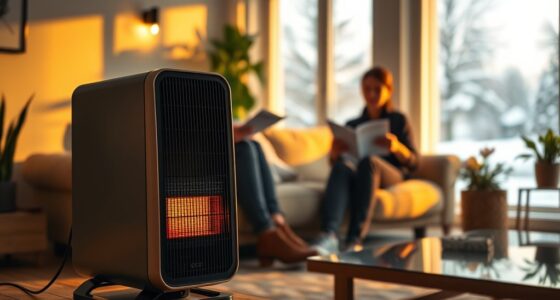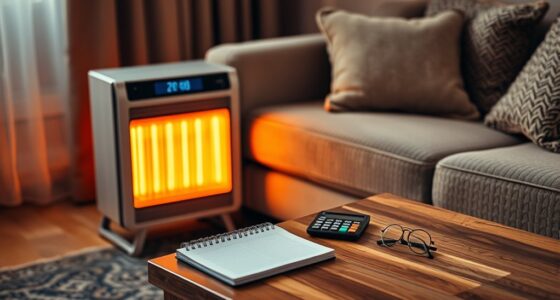Understanding 120V versus 240V heating helps you choose the right system for safety and efficiency. 120V is common for small appliances and safer for home use, while 240V provides more power for larger heaters and faster heating. Your choice depends on your space, safety considerations, and installation setup. Continue exploring to discover how each option affects performance and what’s best for your heating needs.
Key Takeaways
- 120V heating devices are suitable for small spaces and use standard outlets, while 240V heaters are designed for larger areas and require special circuits.
- Higher voltage (240V) allows for greater heating capacity and faster heat delivery compared to 120V systems.
- 120V systems are generally safer due to lower shock risk, but proper wiring and grounding are essential for both voltages.
- Compatibility depends on your home’s electrical wiring; 240V units need dedicated circuits and possibly specialized outlets.
- Correct voltage use ensures safe, efficient operation and prevents damage or overload of heating appliances.
What Do 120V and 240V Mean?
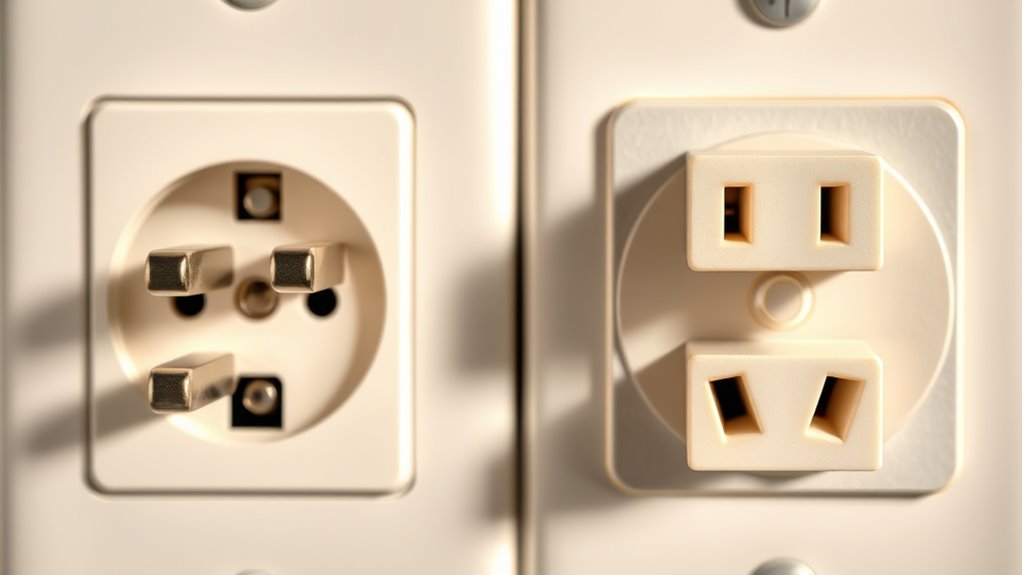
Understanding what 120V and 240V mean is essential when choosing a heating system. These are voltage standards that determine how much electrical power your devices need. In homes, 120V is common for outlets and small appliances, while 240V supplies higher power for larger appliances like dryers and ovens. Electrical wiring must support these voltages, meaning wiring for 240V systems has thicker insulation and separate circuits. Knowing these differences helps you select the right heating device that matches your home’s wiring and power capacity. Using the correct voltage guarantees safety and efficiency, preventing overloads or damage. Whether you’re installing a new heater or upgrading your system, understanding voltage standards and electrical wiring is key to making an informed, safe choice.
How Do These Voltages Power Heating Devices?
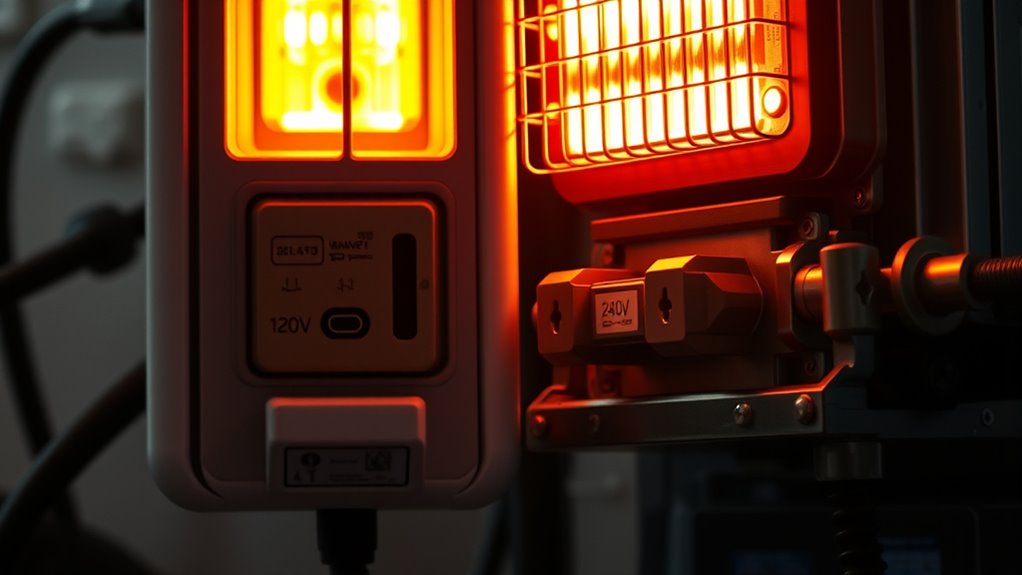
Electrically powered heating devices convert electrical energy into heat through resistive elements, and the voltage supplied directly influences how much power they can draw. Higher voltage allows devices to draw more current, producing more heat efficiently. Voltage conversion plays a key role here; devices designed for 120V or 240V are built with specific wiring configurations that match their voltage requirements. For example, a 120V heater typically uses standard single-phase wiring, while a 240V heater often requires a dedicated circuit with two hot wires. These wiring configurations ensure safe and efficient power delivery. When connected correctly, the voltage supplied determines the device’s heating capacity and overall performance, making it vital to match your device to your home’s electrical system. Proper voltage compatibility is essential to avoid damage and ensure optimal operation of your heating devices.
Which Voltage Is Safer for Home Use?
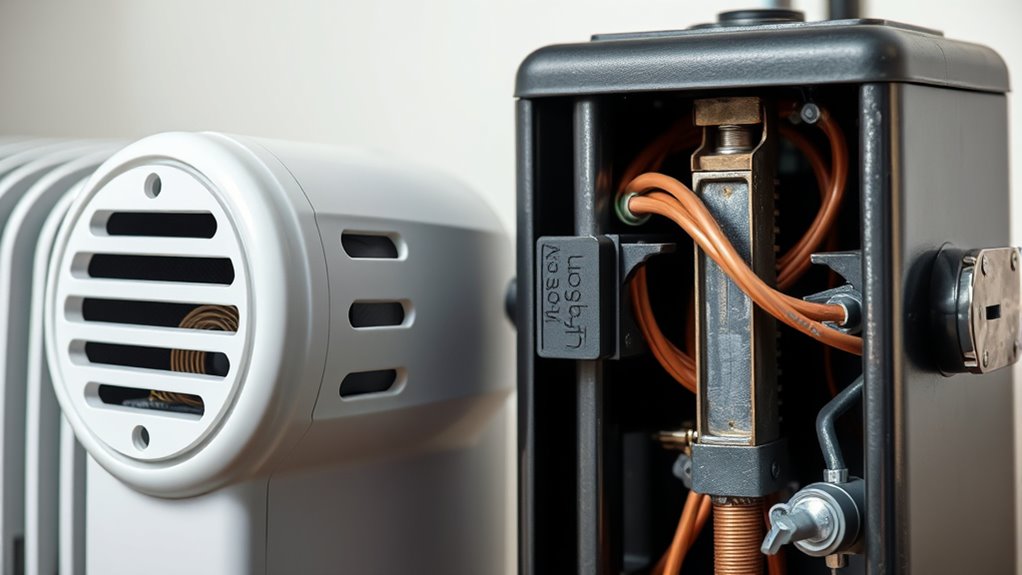
When choosing between 120V and 240V systems for home use, safety depends largely on proper wiring, installation, and adherence to electrical codes. Both voltages can be safe if installed correctly, but 120V systems tend to be safer because they carry less risk of severe electric shock. Grounding safety is vital for both setups; proper grounding reduces shock hazards and protects appliances. Appliance compatibility also matters—using devices designed for the correct voltage minimizes risks. While 240V systems might pose a slightly higher risk if improperly installed or grounded, adhering to safety standards ensures safe operation. Additionally, understanding the role of attention in ensuring safe electrical practices can help prevent accidents. Ultimately, your safety depends on professional installation, correct grounding, and choosing appliances compatible with your home’s voltage system.
Performance Differences Between 120V and 240V Heaters

The voltage level directly impacts how efficiently and quickly heaters can warm a space. 240V heaters typically deliver higher power output, allowing you to heat larger areas faster and more effectively than 120V units. Because of this, they often have lower power consumption for bigger spaces, making them more efficient overall. Voltage compatibility guarantees you get the best performance without overloading your system. Additionally, understanding electrical requirements ensures safe and optimal heater operation.
Installation and Compatibility Considerations
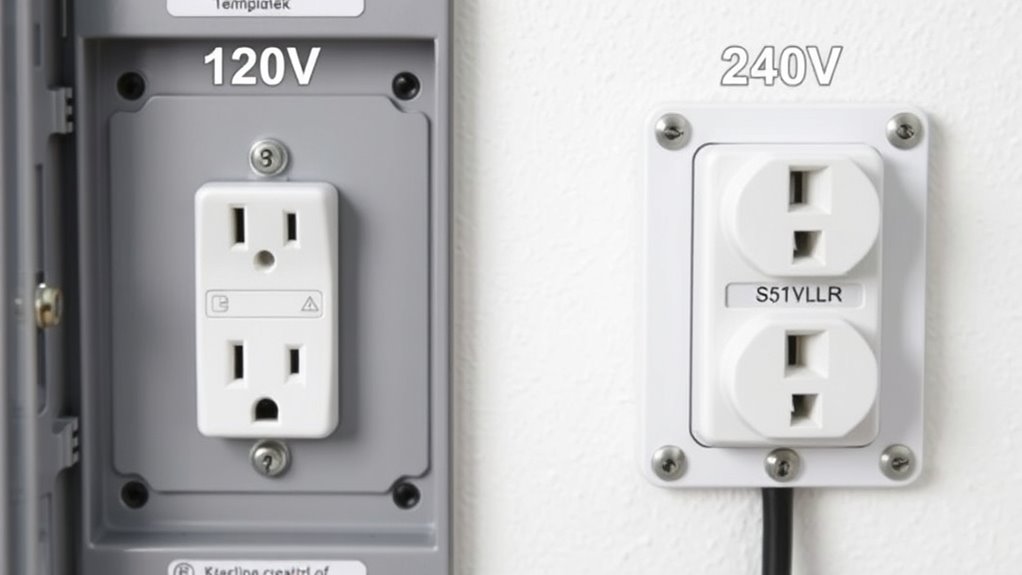
Installing 120V or 240V heaters requires guaranteeing your electrical system can handle the specific voltage and power requirements. You need to check wiring compatibility to prevent overloads or hazards. For 120V heaters, standard outlets typically suffice, but confirm they meet the device’s outlet requirements. In contrast, 240V heaters often require dedicated circuits and specialized outlets, such as NEMA 6-15 or 6-20, to ensure proper connection and safety. Before installation, verify your breaker capacity and wiring gauge, as mismatched components can cause electrical issues or fire hazards. If your current setup isn’t compatible, upgrading your wiring or outlets might be necessary. Proper compatibility guarantees safe operation and compliance with electrical codes, so always consult a professional if you’re unsure about your system’s capacity. Additionally, understanding the power requirements of your heater can help prevent potential electrical problems.
Cost and Energy Efficiency Factors
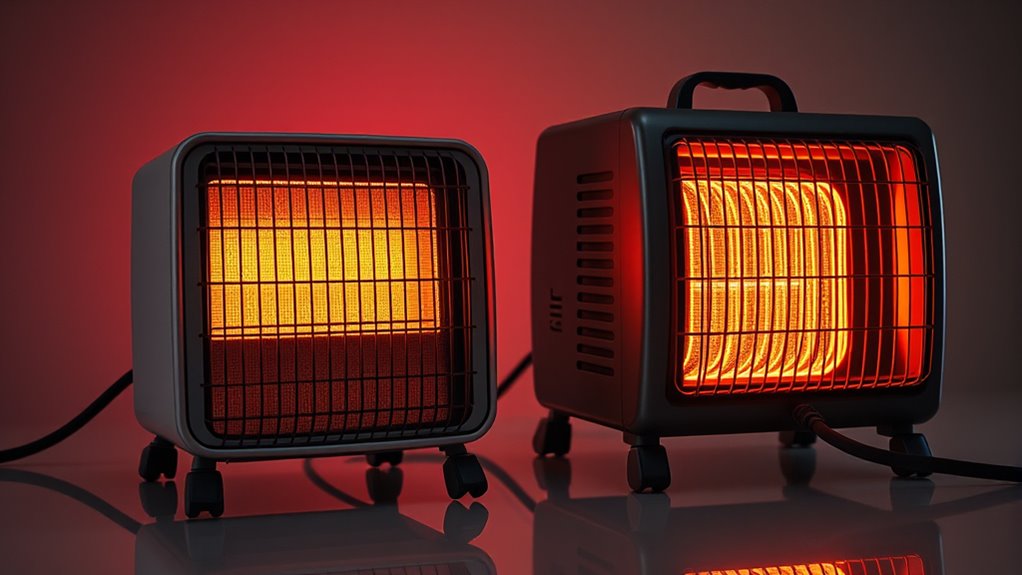
Choosing between 120V and 240V heaters can substantially impact your energy costs and long-term expenses. Generally, 240V heaters are more energy-efficient because they deliver more power with less current, leading to lower energy consumption and cost savings over time. A clear cost comparison shows that although 240V units might cost more upfront, they often save you money through reduced energy bills. Here’s a quick look:
| Feature | 120V Heater | 240V Heater |
|---|---|---|
| Initial Cost | Lower | Slightly higher |
| Energy Efficiency | Moderate | Higher |
| Long-term Savings | Less due to higher energy use | Greater, due to energy savings |
This comparison highlights how choosing 240V can be more cost-effective in the long run. Additionally, understanding the refrigeration cycle can help in choosing more efficient heating or cooling systems.
Choosing the Right Voltage for Your Heating Needs
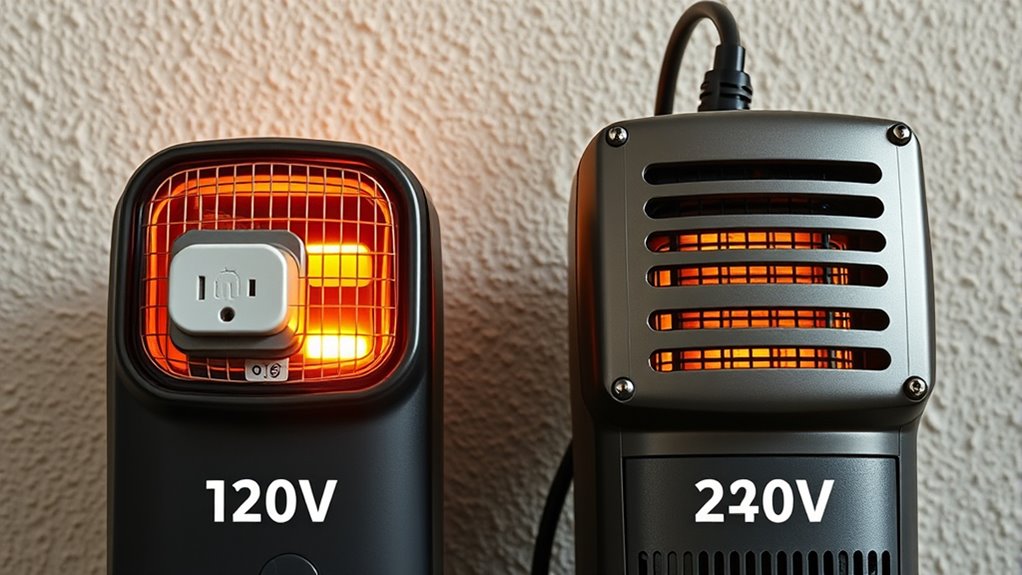
Determining the right voltage for your heating needs depends on several factors, including the size of the space, the power output required, and your existing electrical system. You need to evaluate voltage compatibility to guarantee the heater works efficiently with your wiring. For larger spaces or higher power requirements, 240V options often provide better performance and faster heating. Safety standards are also essential—always select a voltage that complies with local electrical codes and manufacturer guidelines. If your home’s wiring is designed for 120V, installing a 240V heater may require professional upgrades to avoid safety hazards. Ultimately, choosing the correct voltage ensures safe operation, peak performance, and compliance with safety standards. When in doubt, consult an electrician to determine the best option for your specific needs.
Frequently Asked Questions
Can I Convert a 120V Heater to 240V?
You can’t simply convert a 120V heater to 240V, as it requires proper heater installation and electrical safety considerations. The heater’s components are designed for specific voltage levels, so using the wrong voltage can cause damage or dangerous malfunctions. Instead, consult a licensed electrician to evaluate your setup and ensure safe, correct voltage adjustments or consider installing a heater rated for 240V. Never attempt electrical modifications without professional guidance.
Do 240V Heaters Last Longer Than 120V Ones?
While it might seem tempting to assume higher voltage heaters last longer, voltage impact on heater longevity isn’t straightforward. In truth, many factors influence durability more than voltage alone, such as build quality and usage patterns. Generally, 240V heaters can operate more efficiently and handle higher power loads, potentially extending their lifespan. However, proper maintenance and installation are key, regardless of voltage, to guarantee your heater remains a reliable companion over time.
Are There Specific Electrical Codes for 240V Heating Systems?
Yes, there are specific electrical codes for 240V heating systems. You should follow wiring standards and safety regulations set by local authorities and the National Electrical Code (NEC). These codes guarantee proper installation and safe operation. Always hire a licensed electrician to handle wiring, and get the necessary permits. Adhering to these standards prevents hazards, ensures efficiency, and keeps your system compliant with legal requirements.
How Do Voltage Differences Affect Heater Size and Placement?
Think of voltage differences as the root of a tree, shaping your heater’s size and placement. Higher voltage (240V) allows for larger heater capacity without bulky wiring, making installation more streamlined. You need to ensure wiring considerations carefully; 240V systems demand dedicated circuits and proper wiring to handle the power safely. This ensures your heater performs efficiently and safely, fitting seamlessly into your space like a well-placed piece of art.
Is a 240V System Necessary for Large Space Heating?
You need a 240V system for large space heating because it guarantees voltage compatibility and maximizes heater efficiency. Larger spaces require more power, which 120V systems can’t reliably provide without overloading circuits or underperforming. Using a 240V system allows your heater to operate effectively, delivering consistent heat across the area, and helps prevent energy waste or equipment failure, making it the best choice for big spaces.
Conclusion
Choosing between 120V and 240V heating is like picking the right tool for the job—you want efficiency without sacrificing safety. Think of 240V as the swift horse, delivering more power quickly, while 120V is the steady plow, offering reliable performance. Weigh your needs carefully, considering safety, cost, and energy use. With the right voltage, you’ll keep your home warm and cozy, turning your heating system into a trusty ally in your comfort journey.




